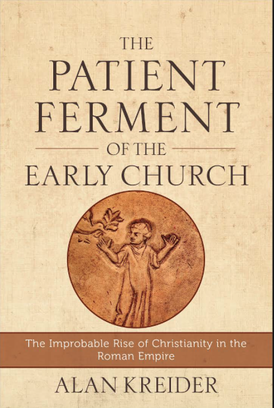posts
 Alan Kreider. The Patient Ferment of the Early Church: The Improbable Rise of Christianity in the Roman Empire. Grand Rapids, MI: Baker Academic, 2016. Pp. xiii+321. ISBN 9780801048494. $26.99 This new work is the latest from Alan Kreider (1941-2017), professor emeritus of church history and mission at Anabaptist Mennonite Biblical Seminary (note: Prof. Kreider passed away in the Spring of 2017. May he rest in peace). The Patient Ferment certainly resembles Kreider’s previous books on the emergence of Christendom in the early church and Roman Empire, including The Origins of Christendom in the Christian West (2001), The Change of Conversion and Origin of Christendom (2007), and Worship and Mission After Christendom (2011). Other related works include Ramsey MacMullen’s Christianizing the Roman Empire (1984) and Andrew McGowan’s Ancient Christian Worship (2014). As the title indicates, Kreider’s central thesis is that the Christian faith—an otherwise superstitio from insignificant Palestine—captured the hearts and minds of Roman pagans because of the transformed habitus of Christian believers. This patient witness that grew over time, particularly in the first three centuries, proved to be attractive to the Romans. In parts 1 and 2 of the book, Kreider argues for this patient growth of the church in pagan Rome, while in part 3, he discusses the means through which the Christian habitus was formed—particularly catechesis and worship. Finally, in part 4, in good Anabaptist fashion, he claims that this patient ferment began to be lost with the emergence of the Emperor Constantine and through the influence of the church father Augustine of Hippo. There is much to like about this book. In typical Kreider fashion, he thoroughly engages ancient texts and the best current scholarship to advance his thesis that Christianity conquered the hearts of many Romans prior to the rise of Constantine through a patient witness. Certainly, his Anabaptist lenses on early Christian history—especially regarding the aversion to killing and the lack of political power possessed by Christians—come to bear in this work. I also find it refreshing that Kreider looks at the early church and its thinkers from a missiological perspective, which is certainly uncommon in patristic studies. While Kreider’s chapters on forming the habitus (on catechesis and worship) are not terribly groundbreaking, he does do a good job of situating early Roman church worship—practices such as the sharing of meals and liturgy—within the context of the Roman world. In that sense, he is a faithful guide to show how the Jesus movement of the eastern Mediterranean world became Roman Christianity. Finally, Kreider does a good job of evaluating the conversion of Constantine against the grid of third- and fourth-century initiation (evangelism, catechesis, baptism) and he successfully argues that Constantine was not regarded by the church as a believer until his baptism at the end of his life. Given these strengths, I do have a couple of constructive critiques. First, while Kreider’s central argument that the Christian habitus—the visible way of life among pagans—was the main strategy for early Christian mission, he seems to downplay the place of gospel proclamation in mission. Without a doubt, Christians witnessed through their daily character in the marketplace and public square as religious minorities. However, though a religio illicita, Christianity was still very much a public religion in Rome and there is good evidence that open proclamation took place on interpersonal levels but also through the work of itinerant evangelists as the author of the Didache, Origen, Eusebius have reported. Also, the pre-Constantinian ministries of Gregory Thaumaturgus, Gregory the Enlightener, and arguably Irenaeus of Lyons point to the work of ministers engaged in evangelistic proclamation. So while I affirm his claims of the Christian habitus being key to a patient witness, I think more space could have been given to the place of proclamation in early Christian mission. Second, in the final chapter, Kreider asserts that through allowing and even affirming state intervention into religious disputes (with Donatists and Pelagians), Augustine set into play a “missional revolution” in which “the carriers brought a gospel in which impatient, forceful actions—animated of course by loving intentions—replaced patient actions” (p. 294). This element of Kreider’s argument was quite brief and rather unconvincing and could have used much greater support in the way of argument and documentation. What is ironic to me is that Augustine’s engagement with the Donatists and Pelagius and those they influenced was a narrative marked by much patience that included much writing, traveling, and meeting to defend sound teaching. I would add that persuasion and teaching remained Augustine’s primary means of striving to reach these groups. In summary, I think that students and professors of early Christianity in the Roman Empire would benefit from this book. Also, given the book’s emphasis on witness through a patient Christian habitus, I think many pastors today would be challenged by it as they minister in a fast paced society and lead busy churches that are often packed with activity. Comments are closed.
|
Archives
November 2023
|
 RSS Feed
RSS Feed
